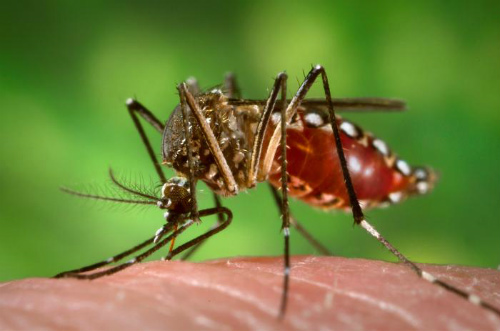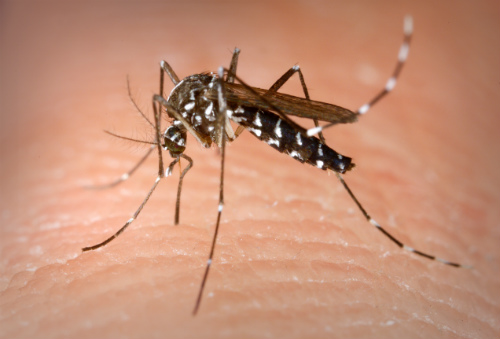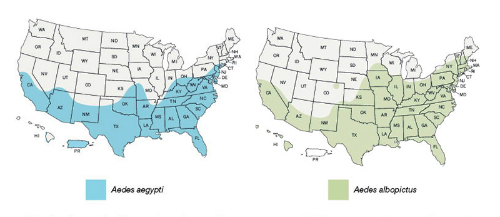- Nearly 300 pregnant, Zika-infected Americans currently being monitored by the CDC.
- Zika linked to microcephaly, seizures and spasticity, facial abnormalities, and problems with feeding and vision in newborns.
- Disease linked to Guillain-Barré syndrome and Zika-related eye injury in adults.
- Nearly 6000 cases of microcephaly have been confirmed in Brazil.
It seems almost daily that alarms over Zika virus infection in the U.S. become more urgent. The Centers for Disease Control and Prevention is currently monitoring hundreds of pregnant Americans and thousands of other adults are infected as well.
By working to educate patients, physicians can help prevent microcephaly and other birth defects as well as Guillain-Barré syndrome and newly detected Zika-related eye injury in adults. Zika is carried by two mosquito species—Aedes aegypti and Aedes albopictus. (Figure 1 and 2.)

(Source: By James Gathany [Public domain], via Wikimedia Commons.)
This month, the World Health Organization released a list of additional birth defects believed to be linked to Zika, including seizures and spasticity, facial abnormalities, and problems with feeding and vision; all part of a congenital Zika syndrome.
Nearly 6000 cases of microcephaly have been confirmed in Brazil. In the U.S. the first case of Zika microcephaly was reported in February. More have been observed since. Increasingly, infected pregnant women are choosing to terminate their pregnancies.

(Source: James Gathany/CDC [Public Domain] via Wikimedia Commons.)
“By midsummer you will start to see Zika cases transmitted by mosquitoes in the southern U.S.,” suggested Nitin S. Damle MD, MS, President of the American College of Physicians and a Clinical Assistant Professor of Medicine at the Alpert Medical School of Brown University.
Alarm with the U.S.
The CDC recently held briefings with governors from Alabama, Arizona, Florida, Louisiana, Mississippi, New York, Texas, Georgia, Hawaii, and California. The states reviewed preparedness plans that include CDC Emergency Response Teams. Mosquito control programs are now widespread in the United States. The mosquitoes that carry Zika currently inhabit at least half of the U.S. states. Mosquito-to-human transmission is considered a near certainty by physicians and the CDC. (Figure 3.)
By advocating for the use of EPA-approved insecticides and the use of condoms for any type of sexual intercourse—even among monogamous couples—physicians can significantly reduce the incidence and the spread of Zika infection.

of Aedes aegypti and Aedes albopictus mosquitoes in the U.S.
(Source: CDC.gov.)
Many experts believe that the first vector-borne transmission is highly likely. Americans already routinely travel to Zika-infested countries, are infected, and return home. Because Zika is sexually transmitted, infected males can easily pass the disease on to an intimate partner.
Because Americans spend more time outside during the day in the summer, they are more likely to be exposed to both of the mosquitoes that carry Zika. Both of these mosquitoes hunt during the day, as well as at dawn and dusk. Both are currently present within the continental U.S. If a mosquito feeds on an infected person it transmit the virus to the next person it bites.
The CDC recommends that Americans cover exposed skin and use an EPA-approved insect repellent any time they are outside, and that they use window screens and bed netting when inside.
However, not all healthcare workers with a knowledge of Zika are worried about it becoming epidemic in the U.S.
Shannan Rossi, PhD, for instance, a virologist and research scientist at the University of Texas Medical Branch in Galveston, Texas, is not convinced, according to an interview published recently in New York Magazine.
In South and Central America there are higher mosquito-to-person ratios. “If you go down to Brazil, for example,” Dr. Rossi told New York Magazine, “they don’t have screens on their windows, very few places have air conditioning, and they’re in an environment where the mosquitoes have contact with them almost all the time.”
“In previous outbreaks like the one that you saw for chikungunya and dengue, that was really a huge factor in prohibiting the virus from establishing itself in the U.S.” She also points to the fact that you’ll see cases of dengue on the Mexico side of the Rio Grande, but not on the Texas side, according to New York Magazine.
Preventing Birth Defects
The physician should ask whether a patient has been exposed to Zika or has been infected. Men should wait 6 months before attempting to conceive and should wear a condom for that period during any type of sexual intercourse. A woman should wait 8 weeks before attempting to conceive after exposure to Zika.
Infection Prevention
The 2 species of mosquitoes that carry Zika currently inhabit more than half of the states in the U.S., according to the CDC. The CDC recommends the following strategies for prevention:
- Patients should use an EPA-approved insect repellent that contains DEET on all exposed skin, taking special care to apply repellent to the neck, ears, face, and scalp, as well as exposed lower arms and legs. DEET is safe for children, pregnant women, and all adults.
- Patients should wear clothing that covers as much of the body possible—whenever possible.
- EPA-approved insect repellents should be applied after sunscreen is applied.
